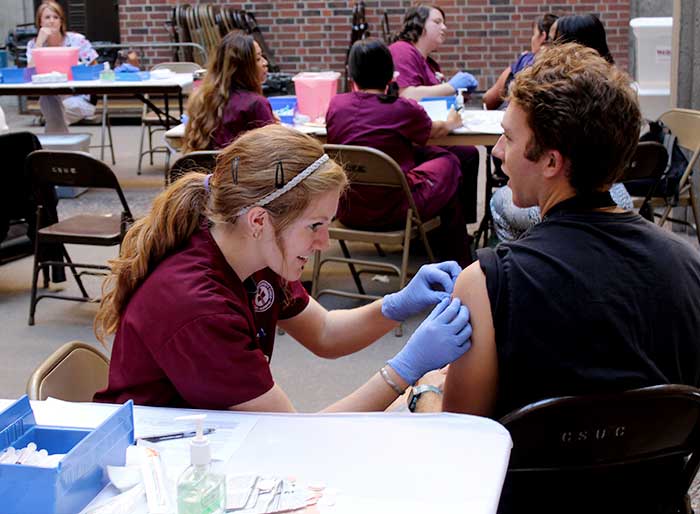
Many may have experienced a sneeze-attack in class and don’t think anything of it. Meanwhile, millions of tiny particles are released into the air and continue to circulate in that area for the rest of class.
The classroom is actually the focal point of virus transmission. About 30 percent of the time that one is exposed to a flu virus, that individual will end up contracting the sickness, according to Nip Boyes, assistant director of the Butte College Health Center.
“If you’re taking classes that you cannot miss a day, get the flu shot,” Boyes said. “This is not a place where you can be out for a week.”
While school is an easy place for anyone to come in contact with the virus, only 13 percent of surveyed college students reported getting the flu vaccine.
Although no method is 100 percent preventative, there are a few ways to avoid the flu.
The best way to block the virus is through vaccination. Students who are in intense classes, where participation is vital, should do everything possible to avoid getting the flu, Boyes said.
In Chico, there are many places for students and teachers to get flu shots at little to no cost.
The Student Health Center offers free flu shots while supplies last. All Butte County health clinics are also offering the vaccine as well as Enloe Medical Center. Convenient pharmacies in Chico, such as Rite Aid and Walgreens, also offering the vaccine.
However, within the influenza virus, there are different types, or “strands,” that the vaccine hopes to combat.
Type A is constantly-changing and harder to create a good vaccine match for, Boyes said. It is typically responsible for the bulk of the flu outbreak each year.

Type B consists of less severe symptoms, but still adds to the long flu season. Although this is a less severe sickness, if left untreated, Type B can still be harmful.
However, the flu vaccine is not a perfect solution. In 2014, the flu vaccine was not as effective as doctors had hoped.
Doctors and nurses admitted the vaccine was far more successful in stopping Type B, which came later in the annual flu season.
Depending on the match of the virus to the vaccine, the effectiveness of the flu shot can range, but is still the best way to avoid the flu.
Other preventions include:
- Hand washing (not just hand sanitizer use)
- A healthy diet
- Exercise
- A regular sleep schedule
- Stress reduction
Close living quarters, shared bathrooms and late-night social activities can make it hard for college students to avoid the flu virus. When students do get the flu virus, it’s important to know when to go to the doctor, Boyes said.
“If you can get there in the first 48 hours, there has been some success minimizing symptoms and severity of the flu infection using anti-viral medicines,” Boyes said.
The best anti-virals to use include Tamiflu and Relenza, which are both prescription drugs that require a doctor’s visit, he said. Beyond anti-virals, the flu is hard to kick without at least a few days of rest and recovery.
Although the symptoms may lessen or disappear altogether, a person with the influenza virus is still contagious for seven days, Boyes said.
While students are going to school every day and interacting with others, it is vital they take every measure possible to avoid the flu virus, he said.
“In the classroom, we have a closed area,” Boyes said. “The kid that sneezes across the room from you releases millions of nuclei that are infectious, and statistically, a third of the class will be infected.”
Sarah Strausser can be reached at [email protected] or @strausser_sarah on Twitter.








